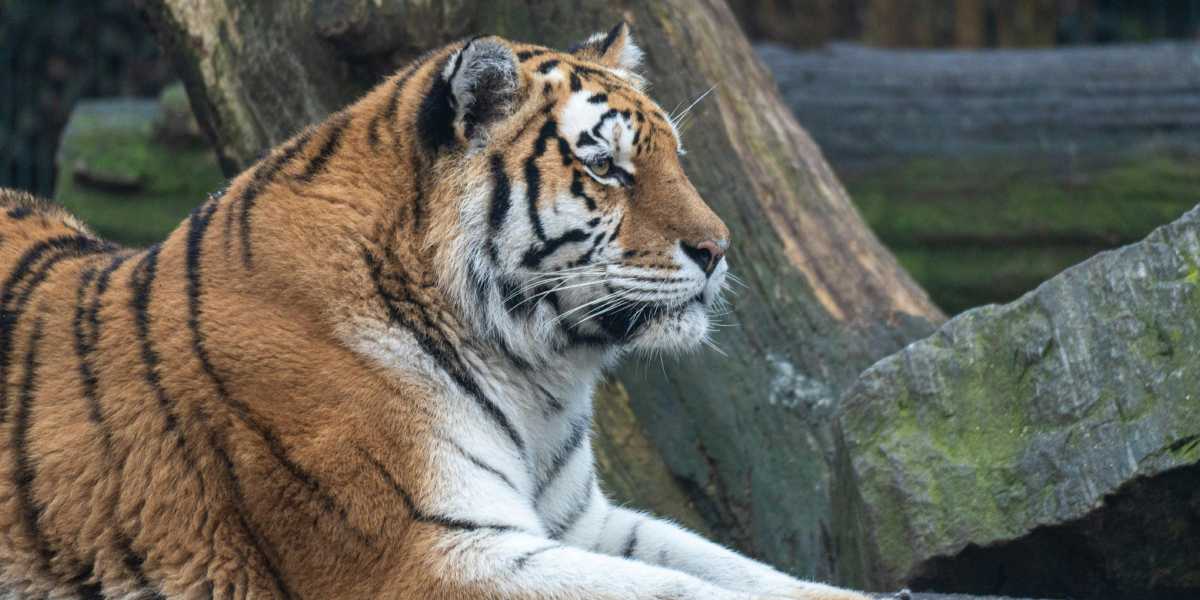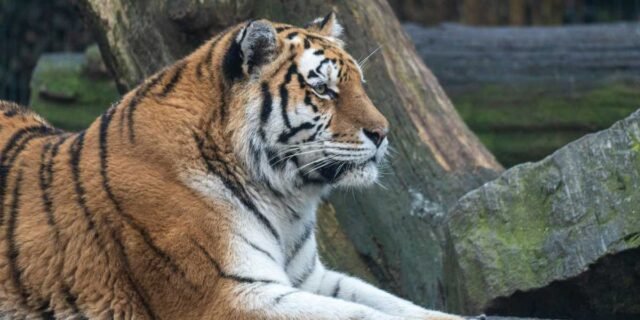The research found a concerning picture of how human activities are leaving their mark not just on tiger habitats, but inside the animals themselves — changing the composition of the gut microbiome.

A tiger.
Synopsis: A study discovered that human presence around India’s tiger reserves is fundamentally changing the composition of trillions of bacteria living inside their digestive systems. For carnivores like tigers, a healthy gut microbiome is essential for efficiently digesting meat, maintaining strong immune defences, and successful reproduction.
In a study, scientists have discovered that human presence around India’s tiger reserves is fundamentally changing something invisible but critical to the big cats’ survival: The trillions of bacteria living inside their digestive systems.
The research, conducted by the Hyderabad-based CSIR-Centre for Cellular and Molecular Biology (CCMB), analysed tiger droppings from five major reserves across India over a two-year period. What they found paints a concerning picture of how human activities — from tourism to mining — are leaving their mark not just on tiger habitats, but inside the animals themselves.
“The gut microbiome is like a hidden indicator of health,” the researchers explained. “When human activities disturb tiger habitats, they may also be disturbing the invisible microbial balance inside the animals.”
Also Read: Two tigers recorded by camera traps in TN’s Cauvery wildlife sanctuary after 50 years
Why gut bacteria matter for tigers
Gut bacteria are far more than passive residents. These microorganisms play crucial roles in digesting food, absorbing nutrients, regulating the immune system, and fighting off infections. In humans, disrupted gut bacteria have been linked to diabetes, obesity, Alzheimer’s disease, and autoimmune conditions.
For carnivores like tigers, a healthy gut microbiome is essential for efficiently digesting meat, maintaining strong immune defences, and successful reproduction. An imbalanced bacterial community could compromise these vital functions, ultimately threatening the species’ survival.
The research team collected 96 scat samples across Corbett Tiger Reserve in Uttarakhand, Kanha and Bandhavgarh in Madhya Pradesh, Tadoba-Andhari in Maharashtra, and Periyar in Kerala. Of these, 47 were confirmed as tiger samples through DNA analysis, representing 19 females and 17 males.
Using advanced DNA sequencing techniques, scientists identified 19,520 unique bacterial types from 43 samples collected during the monsoon, summer, and winter seasons. The samples came from both core zones — the most protected areas with minimal human access — and buffer zones where villages, farming, cattle grazing, and tourism are common.
Each reserve has its own bacterial signature
Tigers in different reserves harbour strikingly different bacterial communities. Bandhavgarh was dominated by Bacteroidota (35%) and Fusobacteriota (23%), while Kanha showed the reverse — Fusobacteriota (34%) followed by Bacteroidota (22%). Corbett had the highest Firmicutes A (35%), while Periyar and Tadoba were dominated by Proteobacteria (32% and 31%).
Kanha had the richest bacterial diversity with 2,748 genera — 1.4 times more than Bandhavgarh, Corbett, and Tadoba (1,870-2,028 genera). Periyar had the lowest with just 1,391 genera.
Beyond shared characteristics, each reserve had unique bacterial fingerprints. Periyar harboured 11 unique genera, including gut-health-associated Akkermansia and Bifidobacterium, the most of any reserve. Bandhavgarh and Kanha each had four unique genera, Corbett had one, while Tadoba had none.
All reserves shared 28 “core” bacterial genera, but the researchers noted that “distinct bacterial signatures exist across reserves, potentially influenced by environmental and ecological factors.”
Also Read: How a drug ban and open carcass crunching revived the vulture population in Tamil Nadu
The human fingerprint
Perhaps most concerning was evidence that human activities are reshaping tiger gut bacteria in measurable ways. The study found that bacteria capable of breaking down toxic chemicals, including toluene, styrene, bisphenol, and polycyclic aromatic hydrocarbons, were more abundant in areas with higher human interference.
This was particularly evident in Tadoba, where open-cast coal mines and thermal power plants operate nearby. The enrichment of pathways for styrene degradation suggests the tigers’ gut bacteria are adapting to environmental contaminants.
Kanha showed the highest abundance of functions related to breaking down xenobiotics — foreign chemical compounds — followed by Bandhavgarh, Corbett, and Tadoba. This pattern likely reflects proximity to villages and the intensity of wildlife tourism in these areas.
“What humans do outside the tiger ends up influencing what happens inside the tiger,” the researchers emphasised.
Seasonal shifts in the gut
The bacterial communities also changed significantly with the seasons. Monsoon and winter samples showed particularly distinct patterns, likely reflecting changes in prey availability, diet composition, and stress levels as weather conditions shift.
The study identified 29 bacterial genera common across all three seasons, but each season also had unique signatures. The monsoon season harboured three unique genera, summer had three different ones, while winter had none.
This seasonal variation highlights how environmental changes ripple through the entire ecosystem, affecting even the microscopic life within predators at the top of the food chain.
Disease connections raise concerns
The functional analysis revealed another troubling pattern. When the researchers analysed what these bacterial communities were capable of doing, they found enriched pathways associated with various diseases known from human medicine, including Type 1 and Type 2 diabetes, lupus, Alzheimer’s disease, and gastrointestinal infections like shigellosis.
This doesn’t mean the tigers are sick, the researchers cautioned. Rather, it suggests that human pressures may be nudging gut bacterial communities in potentially harmful directions. The researchers acknowledged that these predictions are based on human medical knowledge and should be interpreted carefully, but they provide important baseline data for understanding how environmental pressures might affect tiger health.
India is home to over 50 percent of the world’s remaining wild tigers, with populations increasing in recent years thanks to strict protection measures. However, conservationists warn that simply counting tigers isn’t enough — the quality of their habitats and, now, their gut health must also be safeguarded.
“With extensive knowledge available in the human gut microbiome and its role in health and wellness, it is crucial to understand the gut microbes of animals in the wild,” the authors wrote. “The gut microbiome serves as a key indicator of tiger health and habitat quality.”
The study found that collectively, factors including reserve location, zones with different levels of human disturbance, season, and sex explained significant variations in bacterial composition. Statistically, the reserve location and season were the most important factors shaping these microbial communities.
Also Read: Toxic Farmlands Threaten India’s Grassland Birds and Ecosystem
A new conservation tool
The researchers are calling for gut microbiome monitoring to become a standard part of tiger health assessments, similar to how stress hormone levels are currently measured through scat analysis. By tracking shifts in bacterial communities, forest managers might detect early warning signs of declining tiger health before visible symptoms appear.
“Managing anthropogenic pressures, such as unregulated tourism and livestock grazing, through microbiome-informed strategies could enhance tiger fitness and disease resilience,” the authors concluded.
They recommend stricter regulation of human activities in buffer zones, better control of unregulated tourism, and limits on cattle grazing inside reserves. Tourism pressure increases stress in tigers, which may alter their microbiome. Cattle grazing exposes tigers to livestock-associated microbes. Mining and pollution force tiger gut bacteria to adapt to degrading toxic compounds.
(Edited by Muhammed Fazil.)









